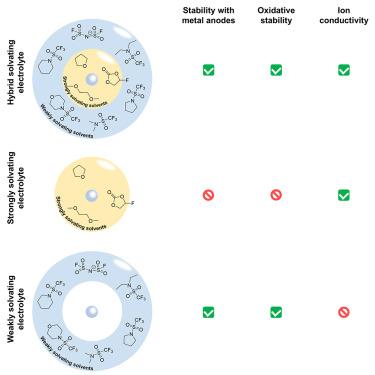Hybrid solvating electrolytes for practical sodium-metal batteries
IF 38.6
1区 材料科学
Q1 CHEMISTRY, PHYSICAL
引用次数: 0
Abstract
Sodium-metal batteries could be competitive against Li-metal batteries, but their applications depend on the stability of electrolytes against sodium-metal anodes and cathodes simultaneously. Here, we propose hybrid solvating electrolytes (HSEs), composed of both strongly and weakly solvating solvents of sodium salts, to tune the solubility, solvation structure, and electrochemical decomposition properties. Fifty HSEs are prepared using the pre-screened candidate molecules, validating the mixture selection requirements and correlations between salt/solvent types and their mixture-dependent performance, including oxidative stability, Coulombic efficiency, and cycling overpotential. A model hybrid solvent formed by mixing weakly solvating N,N-dimethyltrifluoromethane sulfonamide (DMTMSA) with strongly solvating tetrahydrofuran (THF) demonstrates strong beyond-rule-of-mixture effects, showing extraordinarily stable cycling performance against Na3V2(PO4)3 and Na0.44MnO2 cathodes and Na-metal anode. Spectroscopic analysis and molecular dynamics simulations reflect the corresponding change in ion-dipole interaction and solvation structures. The strong-weak hybrid solvating principle for electrolyte design enables practical alkali-metal batteries.


用于实用钠金属电池的混合溶剂化电解质
钠金属电池可以与锂金属电池竞争,但它们的应用取决于电解质同时对钠金属阳极和阴极的稳定性。在这里,我们提出了混合溶剂化电解质(HSEs),由钠盐的强溶剂化和弱溶剂化溶剂组成,以调整溶解度,溶剂化结构和电化学分解性能。使用预先筛选的候选分子制备了50个hse,验证了混合物选择要求、盐/溶剂类型及其混合物依赖性能之间的相关性,包括氧化稳定性、库仑效率和循环过电位。弱溶剂化N,N-二甲基三氟甲烷磺酰胺(DMTMSA)与强溶剂化四氢呋喃(THF)混合形成的模型混合溶剂具有很强的超混合规则效应,对Na3V2(PO4)3和Na0.44MnO2阴极和na -金属阳极表现出非常稳定的循环性能。光谱分析和分子动力学模拟反映了离子偶极相互作用和溶剂化结构的相应变化。电解质设计的强弱混合溶剂化原理使实用的碱金属电池成为可能。
本文章由计算机程序翻译,如有差异,请以英文原文为准。
求助全文
约1分钟内获得全文
求助全文
来源期刊

Joule
Energy-General Energy
CiteScore
53.10
自引率
2.00%
发文量
198
期刊介绍:
Joule is a sister journal to Cell that focuses on research, analysis, and ideas related to sustainable energy. It aims to address the global challenge of the need for more sustainable energy solutions. Joule is a forward-looking journal that bridges disciplines and scales of energy research. It connects researchers and analysts working on scientific, technical, economic, policy, and social challenges related to sustainable energy. The journal covers a wide range of energy research, from fundamental laboratory studies on energy conversion and storage to global-level analysis. Joule aims to highlight and amplify the implications, challenges, and opportunities of novel energy research for different groups in the field.
 求助内容:
求助内容: 应助结果提醒方式:
应助结果提醒方式:


